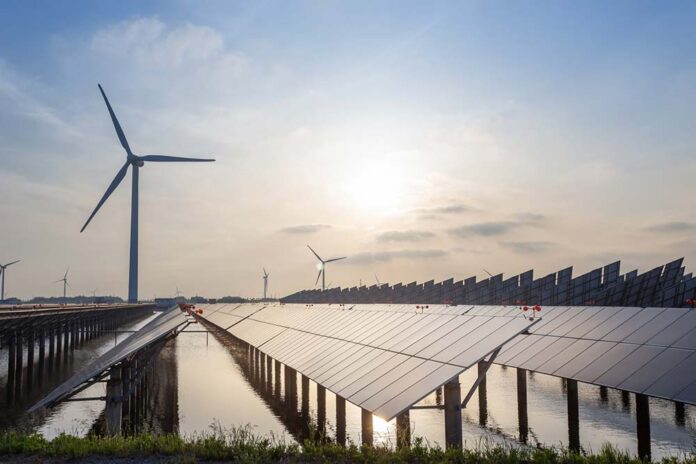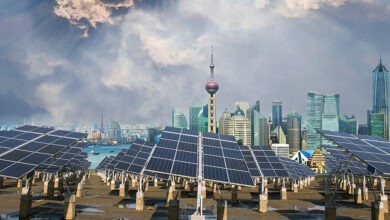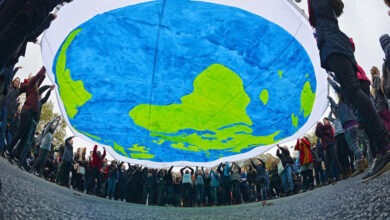Road to, and from, Energy Transition

 Francisco Mauro Brasil de Holanda
Francisco Mauro Brasil de Holanda
A retired Brazilian diplomat, he was the former ambassador to Kuwait, and representative to Palestine. He also served at Brazilian embassies in London, Ottawa, Rome, and Asuncion in Paraguay.
A consensus has emerged about the urgent need to foster energy transition. Past uncontrolled deforestation in today’s developed countries, together with the ongoing escalation of carbon emissions from fossil fuels, has precipitated extreme weather events, including the melting of icecaps in the polar circles; crop-shriveling droughts; and the increasingly frequent and devastating floods and typhoons among other devastations.
These episodes have raised awareness among the international community about the urgent need to act, lest climate change becomes irreversible. Joined by 196 parties, the 2015 Paris Agreement set the overarching goal to hold the increase in the global average temperature ‘to well below 2 degrees Celsius above pre-industrial levels’, and pursue efforts to further reduce it to 1,5 degree Celsius. This is expected to be achieved through a global process of transition towards clean renewable energy sources.
The Paris Agreement recognizes that climate change is a shared problem and called on all countries to set emission targets. A goal of such magnitude involves costly and bold decisions with uncertain results and potentially far-reaching consequences. To make things worse, unforeseen events, such as the COVID-19 pandemic and the ongoing Russia-Ukraine conflict, posed serious additional hurdles. Contrary to the Paris roadmap, both episodes strengthened the role of fossil fuels as the shortest way to ensure energy security.
History assisted many energy transitions before, such as from wood to coal, starting in the 18th century; and from coal to oil, as from the 19th century, after the discovery of the first oil wells in the United States, in 1859. Yet none of them were swift, and all were actually energy additions, rather than energy transitions. It was not until 1900 that coal supplied half the world’s energy demand; and it took until the 1960’s, a century after its discovery, for oil to replace coal as the world’s favorite energy source. It is also notable that all past transitions were driven mainly by economic and technological stimulus, and not by policy, as is the case now, when the world is haunted by gloomy environmental imbalances.
This article is premised on the assumption that there is no alternative to energy transition and that time is short. The plan has four sessions, as follows:
Role of fossil fuels in future: Central to the fate of energy transition, the role and share of fossil fuels in tomorrow’s global energy profile arouses opposing views.
In an article titled ‘A call to clean energy’ in Finance and Development, published in December 2022, the Executive-Director of the International Energy Agency (IEA), Faith Birol stated, “…a massive surge in investments in new energy technologies and energy efficiency could cut global demand for fossil fuels so much that there would be no need for investments in new oil and gas fields. At the same time, continued spending on existing assets, including investments to reduce upstream emissions, remain essential”.
Through a different lens, a press statement by OPEC Secretary General, Haitham Al Ghais, released by OPEC in September 2023 stated, “It is an extremely risky and impractical narrative to dismiss fossil fuels, or to suggest that they are at the beginning of their end. In past decades, there were often calls of peak supply, and in more recent ones, peak demand, but evidently neither has materialized. …Such narratives would lead to energy chaos on a potentially unprecedented scale, with dire consequences for economies and billions of people across the world.”
One might guess if this OPEC statement would be corroborated by the United States and China, that, together with Saudi Arabia account for 40 percent of the world oil supply, and are also (US and China) on the front line in the transition to clean renewable sources.
Taking into account its scale worldwide, as well as its essential role to energy security, it is unreal to see the fossil sector stop growing in the coming years, as much as it is undesirable to shift public policies priorities away from the development of renewables.
From fuel-intensive to mineral-intensive: the new basket of inputs: The transition to a clean renewable economy will be followed by a shift from a ‘fuel intensive’, to a ‘mineral intensive’ energy system. A completely new mix of minerals is required for the production of renewables, vis-à-vis those fueled by hydrocarbons. According to the IEA, “Since 2010 the average amount of minerals needed for a new unit of power generation capacity has increased by 50 percent as the share of renewables in new investment has risen”.
The mix of minerals varies. Lithium, nickel, cobalt, manganese and graphite are crucial to battery performance, longevity and energy density; Rare Earth elements to wind turbines and electric vehicles motors; copper and aluminum for electricity networks. Production and reserves are unequally distributed among different countries. Chile, Peru, China, Congo and the US supply about 60 percent of the world markets of copper.
Rare earth minerals are mostly supplied by China, Australia, US, Russia and India, but other sources have the potential for significant increases in production. Reserves of lithium are mainly located in Chile (9.3 million tons) and Australia (6,2 million tons), followed by Argentina (2,7 million tons) and China (2,0 million tons).
The projected increase in demand for this basket of minerals may open up new opportunities to producers, notably, but not exclusively, to small to midsize economies, such as Argentina, Bolivia, Chile, Peru, Congo, Myanmar and Vietnam. Yet historical evidence shows that being home to abundant natural resources is no guarantee of success. Domestic legal security and wise ‘resources diplomacy’ are also essential to turn opportunities into durable gains, to benefit as many people as possible.
How much will it cost?: The Sharm el-Sheikh Implementation Plan estimates that a global transformation to a low-carbon economy is expected to require investments of at least US$4-6 trillion a year. This will require a firm engagement from governments, central banks, commercial banks, institutional investors and other financial actors.
Across emerging markets and developing economies other than China, it is estimated that $2.4 trillion will have to be spent per year by the end of this decade on three key objectives: transforming energy systems; building climate resilience; and supporting natural capital and sustainable agriculture. To achieve the SDGs more broadly, overall development spending (including the $2.4 trillion) must more than double from its pre-pandemic level, to around $5.3 trillion per year by 2030.
On a longer term perspective, the Intergovernmental Panel on Climate Change (IPCC) estimates that to keep global average temperatures within 1.5° Celsius of pre-industrial levels, greenhouse-gas emissions will have to be reduced by 45 percent (from 2010 levels) by 2030 and achieve net-zero emissions by 2050. According to the Network for Greening the Financial System, this will require a total capital investment of more than US$ 275 trillion by 2050.
Multilateral development banks will be crucial for closing the massive global climate financing gap. But they, too, will need more funding from developed countries, so that they can provide development funds and help crowd-in more private-sector capital. The new ‘loss and damage’ facility announced at the 2022 United Nations Climate Change Conference (COP27) was another welcome development.
An important role in the path to renewables may be played by the major oil companies, many of which are increasingly turning into energy companies. Brazil’s PETROBRAS, a leading oil producer, has announced firm plans to engage in the exploration of off-shore windmills, whose potential may be as high as 700 GW. Notably, Gulf countries are also mobilizing. Saudi Arabia intends to generate 50 percent of its national power supply from renewables by 2030. The onshore facilities of ADNOC, the United Arab Emirates’s (UAE) state oil company, are now supplied by nuclear and solar energy.
Possible consequences of the transition process on power relations: New power relations may come up in the wake of energy transition. The Sino-American competition for global influence; the strengthening of the Moscow-Beijing axis since the conflict with Ukraine; and apparent strains between Washington and Riyadh – reveal a fragmentation among key political players with strong influence on energy markets.
According to some international analysts, new competing blocs may come up as a consequence. In a recent media interview, Carlos Cordon, from the International Institute for Management Development, in Lausanne, foresaw an European bloc; a NAFTA bloc; and three blocs in Asia: one made up of Japan, Taiwan, South Korea, Australia and US; a second one centered on China; and a third one in India.
Apart from these, Cordon notes a potential role to the BRICS and to a group of ‘friendshore countries’, such as Saudi Arabia, and others in the Middle East. He adds that the decisions about supply chains would be mainly political. Different blocs could apply their own regulatory mechanisms in their trade relations.
In conclusion: The transition to renewables is not a matter of choice. It is inevitable and urgent. The longer it takes, the worse. The scale of the challenges ahead is huge and may have ample long term consequences beyond national levels. Mistakes made now will be harder to fix than before.
The dominant position of fossil fuels in today’s energy supply may not change overnight, lest energy security be in risk. But it is essential that it be balanced by the development of renewables. It is reasonable that the transition to renewables follow different paths in different places, provided that the fundamentals of the Paris Agreement be respected.
The support from governments will be decisive to provide adequate financing, especially in cases that the private sector may not be willing or prepared to take the risks. Yet it will have to be supplemented by private flows. The multilateral institutions may help devise the necessary tools to make the machine working, as it has done.
The threat of political fragmentation foreseen by some analysts is a matter of concern, should it materialize, trade relations would be strongly influenced by political, not economic criteria. Some mechanisms of global multilateralism available today would be weakened and international trade would be affected.













